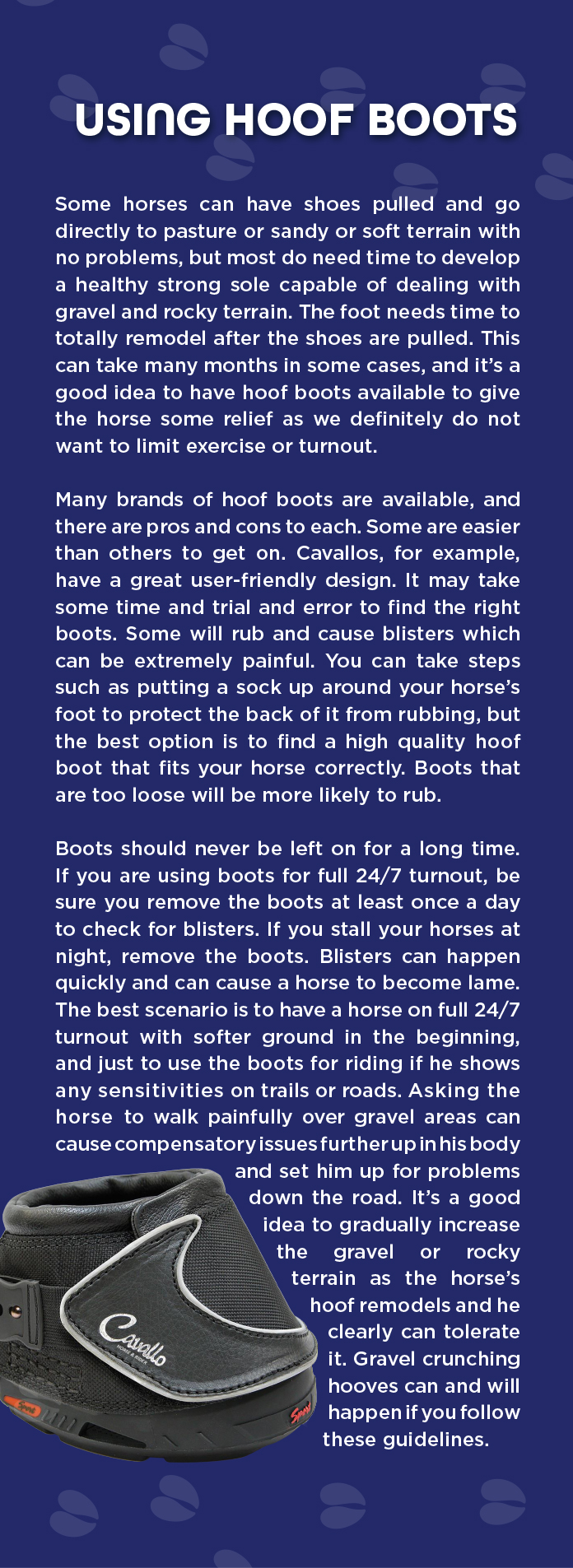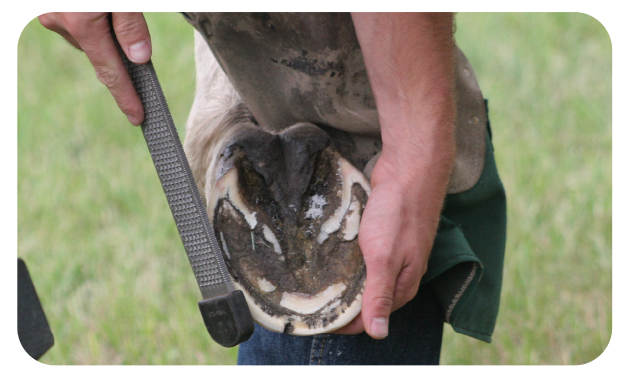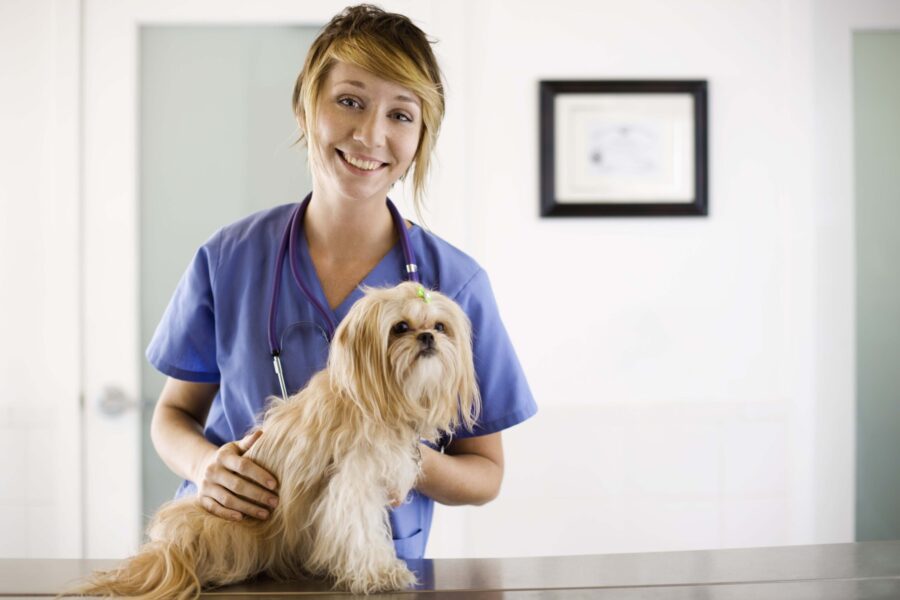We may love the sound of a horse’s hooves clicking down a concrete aisle with his or her shoes on. But are we helping our horses’ hooves or bodies by keeping those lovely-sounding pieces of metal nailed to them? Probably not. Shoes interfere with both shock absorption and energy dissipation. Over time, this will negatively affect the horse’s joints.
When studying the miraculous design of the equine hoof, we see that a huge part of the “hoof mechanism” has to do with flexion. We’re concerned not only with the external hoof that we can see but with the internal hoof structures. Mother Nature designed these structures with perfect physiology. In other words, natural — or barefoot — is better. So let’s take a look at how to get there.
WHY BAREFOOT IS BEST
Let’s look at a few examples of how the hoof is built to function best without the addition of shoes. Grooves on each side of the frog, called collateral grooves, are there for a few reasons. First, they act as expansion joints, allowing the hoof to flex upon impact. They also increase traction and help to hold in packed clean dirt, which works to support the coffin bone when needed.
The frog is another miraculous structure that helps not only to provide cushioning but also to move blood through the foot and shunt it back up the leg when the foot compresses and the heels squish down — expansion and flexion. Proper blood flow in the foot and leg is critical for healthy foot development and so much more.
Any activity that occurs in the foot also impacts the bones directly above the coffin bone. This bony column needs to be considered almost as a tower that can come tumbling down if the bottom support structure is not exactly as it should be.

LET’S TALK ABOUT TERRAIN
Every structure in a horse’s hoof is designed to handle natural barefoot movement on all terrains. The problems arise when humans keep horses in ways that are not natural or beneficial. For example, horses are not equipped to stand on concrete surfaces for prolonged periods. Ever notice how your knees and hips start to ache after treading on hard tile or pavement for more than a few hours? Our horses will suffer the same effects if they aren’t given access to the gentle, natural terrain.
Other lifestyle issues such as keeping horses in confined spaces, stalling, feeding a poor diet, not providing enough forage and necessary minerals, and lack of exercise will negatively affect hoof health. That’s why, as horse caretakers, we need to make improvements for our horses where we can. One of these improvements is removing shoes and slowly transitioning the hooves to a barefoot life, just as they were designed.

START WITH DIET
First and foremost, we need to look at the foundation of hoof health — nutrition. Providing our horses with a mix of both chelated and inorganic minerals, and high-quality constant forage in the form of either hay or pasture, is of vital importance when it comes to hoof health (and overall health). Many soils across the country, especially in the Midwest, are deficient in certain key minerals (zinc, copper, manganese), which means these nutrients need to be supplemented in the diet. We cannot possibly expect a horse’s hooves to properly withstand the natural environment if the nutrition basics are not covered. It takes approximately 90 days for supplements to have full effect and for new blood cells to be produced, so supplements should be implemented as soon as possible when planning to make the barefoot transition. We want the hoof wall to be as strong as possible and the soles to be as thick as possible, and both require a solid diet.

ENLIST THE HELP OF A GOOD TRIMMER
Next, we need to make sure we have a trimmer who understands internal hoof anatomy. It is critical that the toes are kept short enough to prevent leverage from a long toe with a break over that is too far ahead of the coffin bone. This would cause increased stress to the laminae, and depending on how the trimmer handles the heel height (many take way too much heel off), can cause tremendous strain and actually cause the coffin bone to tear away from the hoof wall and rotate inside the hoof capsule.
Flares are another common issue seen on hooves. This distortion involves the horn being stretched outwards and pulled away from the coffin bone. Many conventional farriers will try to rasp the outer wall to conceal or diminish the flare, but this is something that needs to be addressed in the balance of the foot. There are several reasons why flares occur in the first place but it is crucial to make sure the foot is balanced properly when the shoes are removed. This will be a very different “balance” from what conventional farriers use with shod hooves. Correcting flares can and should take time, and with a multi-pronged approach as opposed to just rasping the outer wall. We want the outer wall left as strong as possible and rasping does not help achieve that end.
Many other factors need to be considered when trimming, so making sure you have a highly skilled barefoot trimmer is key.
We all want our horses to be the best they can be, whether they are high-performance reiners, upper-level FEI horses, or beloved backyard pasture pets. Getting as close to a natural environment as we can, including switching to barefoot, is one way we can help them thrive while promoting not only a beautiful outward appearance but stronger immunity and internal strength.
Dr. Angelique Barbara (affectionally called Dr. Angel by many of her clients) is a Doctor of Chiropractic who also holds degrees in Veterinary Science (B.S.), Equine Science (Minor), and Veterinary Pathobiology (M.S.). Dr. Barbara has been passionate about animals her entire life and has also spent most of her life studying them (both in the classroom and the field). She developed her first animal bodywork seminar in 2009. Since then, she has founded Angel’s Animals — Holistic Animal Studies, and her seminars have grown both in number and popularity. Her background in the clinical and research animal health care world, as well as her experience as a human chiropractor, gives her a unique perspective on animal bodywork.
Jennifer Thackery is a co-instructor with Angel’s Animals — Holistic Animal Studies for their Holistic Equine Nutrition, Holistic Carnivore Nutrition, and upcoming Equine Foot and Mouth course. Jen has been active in the veterinary and equine nutrition arena for over 27 years, working as a veterinary technician, teaching at the local business college in their veterinary assistant program, developing their accredited equine program, and teaching those classes along with small animal courses. She studied Naturopathy and Holistic Nutrition in graduate school long after her Bachelors Degree in Biology with an emphasis on pre-veterinary science.
[su_button url=”https://facebook.com/EquineWellnessMagazine” target=”blank” style=”flat” background=”#232969″ color=”#ffffff size=”8″ wide=”yes” center=”yes” radius=”0″ text_shadow=”0px 0px 0px #000000″]Visit our Facebook page for more great content![/su_button]








